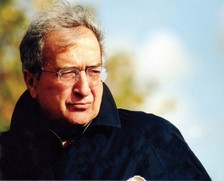
Luciano Berio (1925–2003, Italy) received his first lessons in music from his grandfather and father – organists and composers. After the war, he entered the Verdi Conservatory in Milan, studying at first with Paribeni (counterpoint and fugue), then with Ghedini (composition), and Votto and Giulini (orchestral conducting). He earned his living as an accompanying pianist, meeting this way his first wife, American singer Cathy Berberian, with whom he was to explore the possibilities of voice in numerous works, most notably Sequenze III (1965). In 1952 at Tanglewood he studied with Luigi Dallapiccola, whom he greatly admired, as could be seen in the dedication of Chamber Music (1953). In Basel, attending one of the conferences devoted to electroacoustic music, he met Stockhausen, composing after that his first pieces for tape (Mimusique no. 1). In Darmstadt, Berio met Boulez, Pousseur, and Kagel, and his personal response to serialism came in Nones (1954). He returned to Darmstadt more than once, teaching there in 1960; nonetheless, he kept his distance from the dogmatic ambience that prevailed there. With Bruno Maderna in 1955, he founded the Studio for Music Phonology at the Milan RAI. These explorations gave rise to Thema (Ommagio a Joyce) in 1958. Passionately interested in instrumental virtuosity, in 1958 he started his series of Sequenze, which he finished in 2002. From 1960 on he taught composition in the USA at the Summer School in Dartington, Mills College, Harvard University, Columbia University, and Julliard School of Music, where in 1967 he founded Juilliard Ensemble, specialised in contemporary music. Upon his return to Europe in 1972, Boulez invited him to manage the department of electroacoustic music at IRCAM (1974–1980). During the 1980s, Berio realised two major operatic projects – La Vera Storia (1982) and Un re in ascolto (1984), on libretti by Italo Calvino. Apart from his creative activities, Berio was constantly engaged at various Italian and international institutions. His international fame was acknowledged with numerous prizes, awards, and honours, such as Leone d’Oro at the Venice Biennale (1995) and Premium Imperiale (Japan, 1999).
Sequenza X (1984) for trumpet was Berio’s second Sequenza for a brass instrument, preceded in 1966 by Sequenza V for trombone. The trumpet is treated in a more or less conventional manner; Berio avoids the extended palette of multi-phonics, unusual articulations, micro-intervals, and other novel devices found in most of the other Sequenze. Berio himself explained this attitude as follows: ‘Transformation and the overcoming of idiomatic aspects of instruments are often intrinsic to my earlier Sequenze. In Sequenza X, however, for trumpet in C and piano resonance, there are neither transformations nor “cosmetics”. The trumpet is used in a way that is natural and direct. Perhaps it is exactly this ‘nudity’ that makes Sequenza X the most ambitious of all the Sequenze’.


